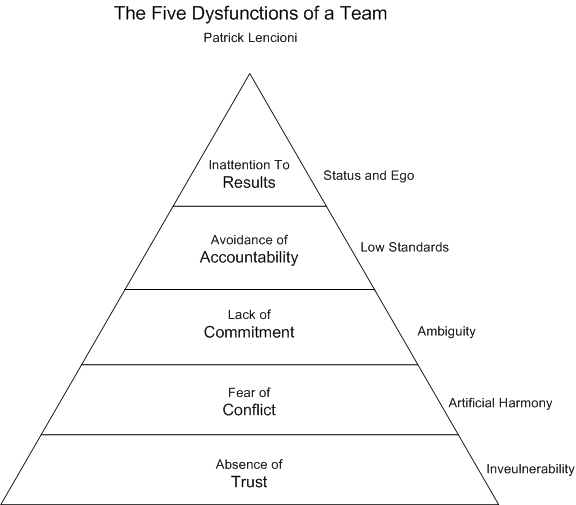

- The first dysfunction is an absence of trustamong team members. Essentially, this stems from their unwillingness to be vulnerable within the group. Team members who are not genuinely open with another about their mistakes and weakness make it impossible to build a foundation for trust.
- This failure to build trust is damaging because it sets the tone for the second dysfunction: fear of conflict.Teams that lack trust are incapable of engaging in unfiltered and passionate debate of ideas. Instead, they resort to veiled discussions and guarded comments.
- A lack of healthy conflict is a problem because it ensures the third dysfunction of a team: lack of commitment. Without having aired their opinions in the course of passionate and open debate, team members rarely, if ever, buy in and commit to decisions, though they may feign agreement during meetings.
- Because of this lack of real commitment and buy-in, team members develop an avoidance of accountability, the fourth dysfunction. Without committing to a clear plan of action, even the most focused and driven people often hesitate to call their peers on actions and behaviors that seem counterproductive to the team.
- Failure to hold one another accountable creates an environment where the fifth dysfunction can thrive. Inattention to results occurs when team members put their individual needs (such as ego, career development, or recognition) or even the needs of their divisions above the collective goals of the team.
These dysfunctions can be mistakenly interpreted as five distinct issues that can be addressed in isolation of the others. But in reality they form an interrelated model, making susceptibility to even one of them potentially lethal for the success of a team.
The opposite approach — a positive one — is to imagine how members of truly cohesive teams behave:
- They trust one another
- They engage in unfiltered conflict around ideas.
- They commit to decisions and plans of action.
- They hold one another accountable for delivering against those plans.
- They focus on the achievement of collective results.
Other references:
- Notes from the book, The Five Dysfunctions of a Team.
- The Skilled Facilitator, Group Effectiveness Model
- Driving Fear out of the Workplace, Cycle of Mistrust
- Trust and Betrayal in the Workplace (book)
